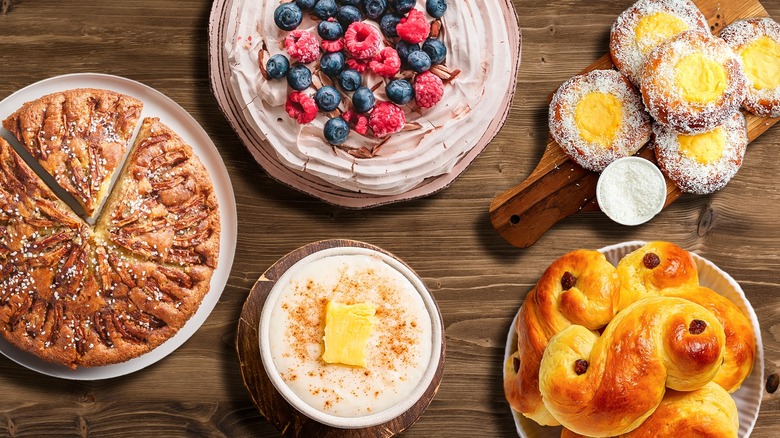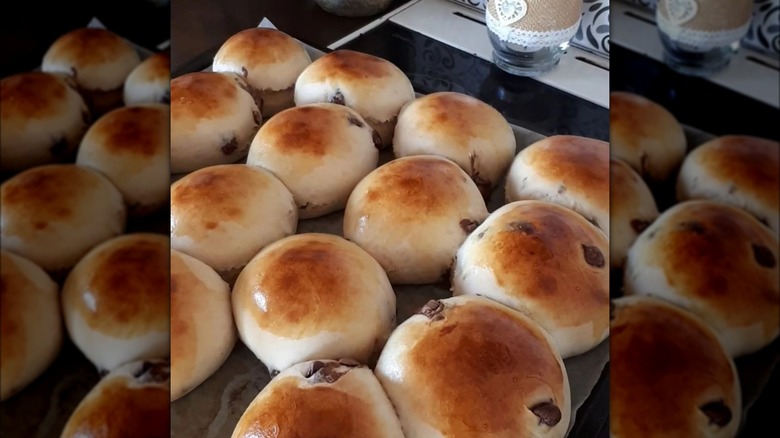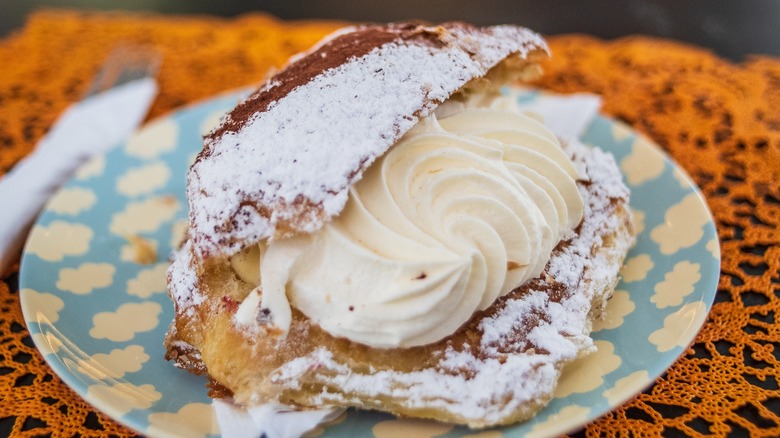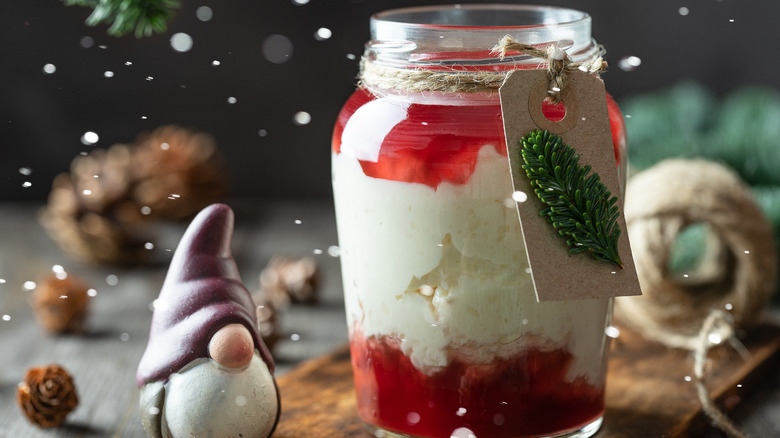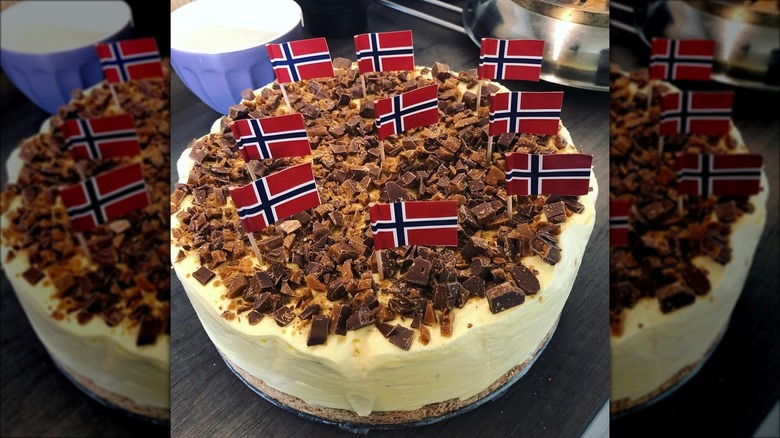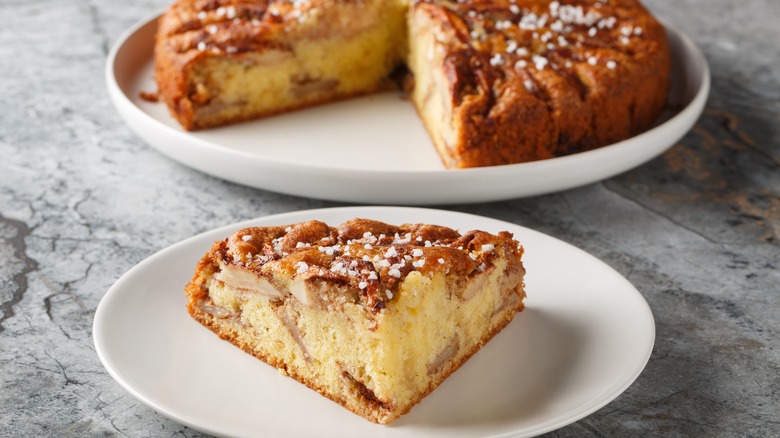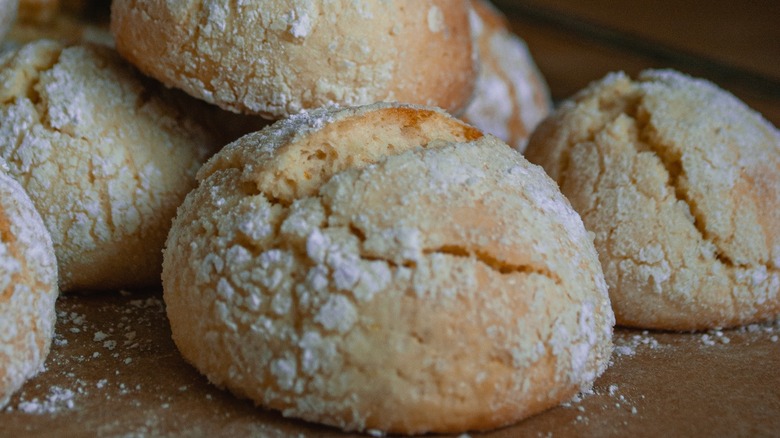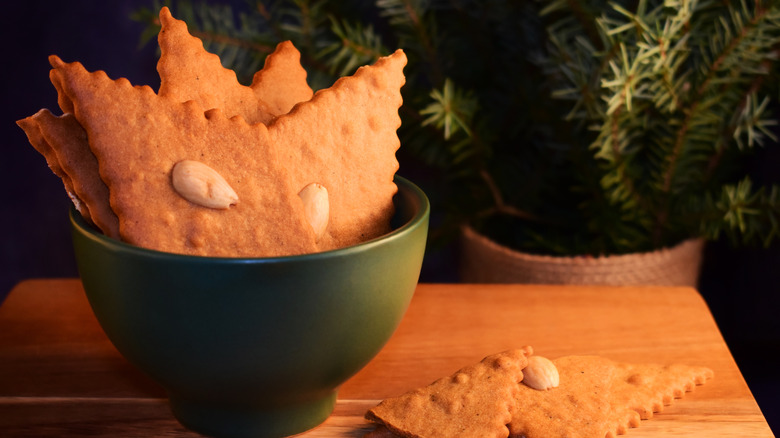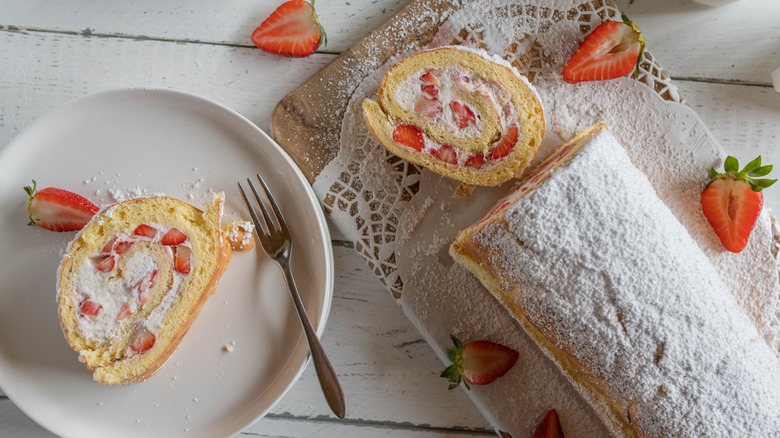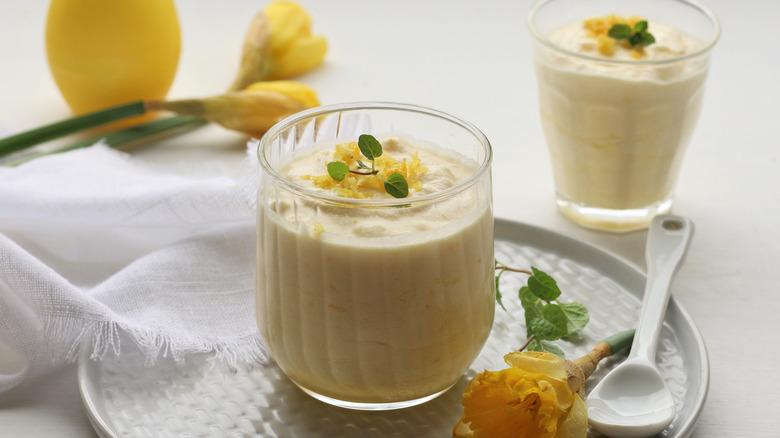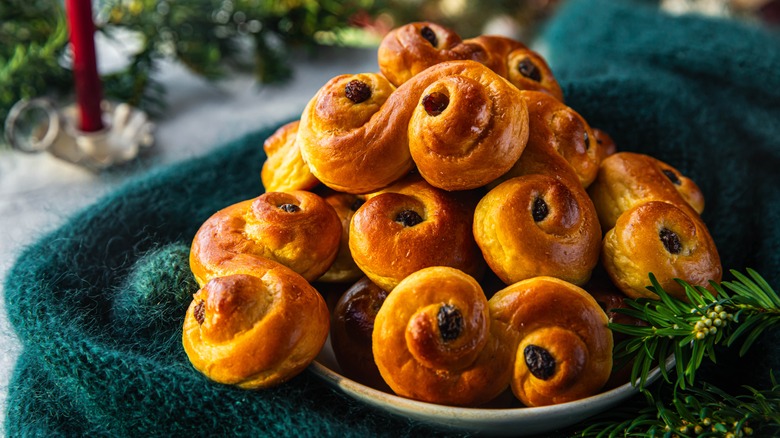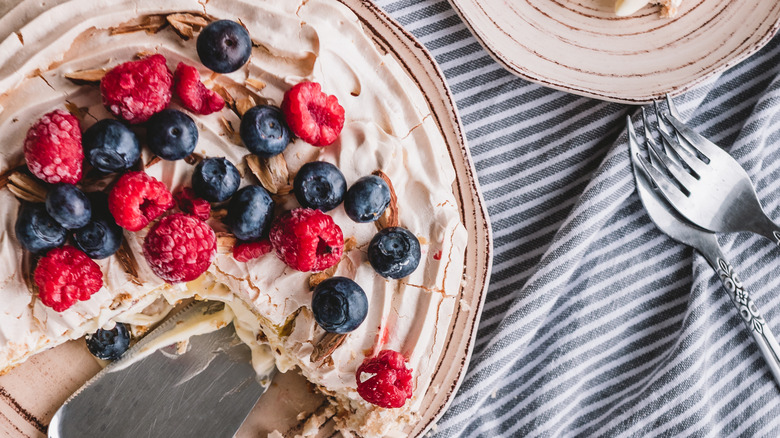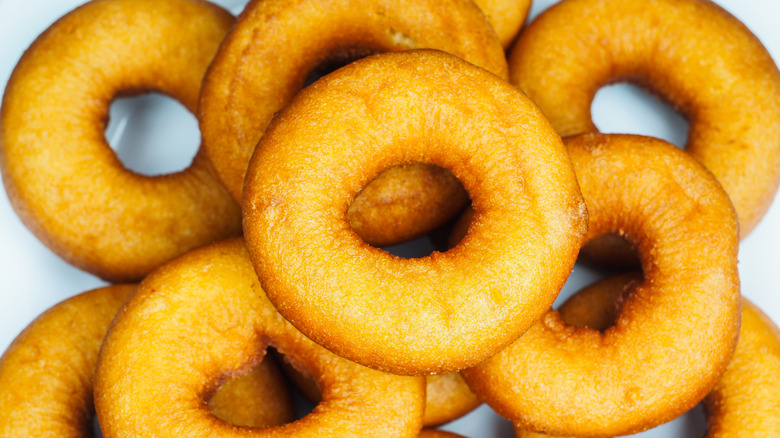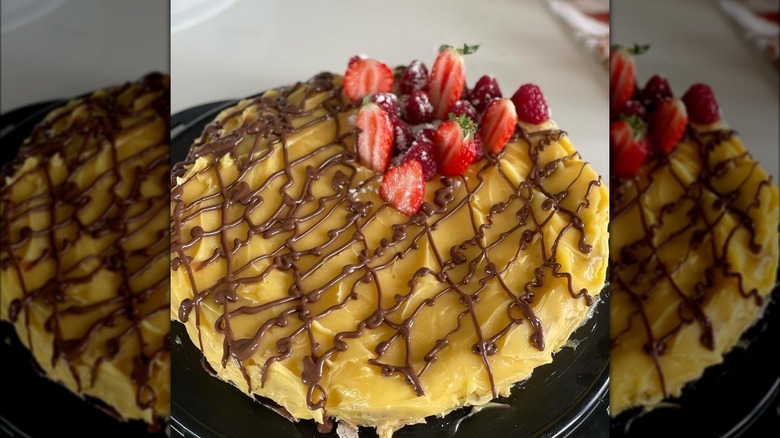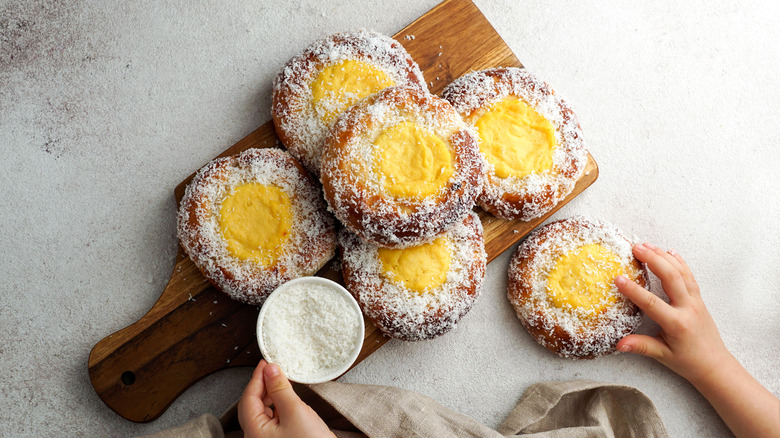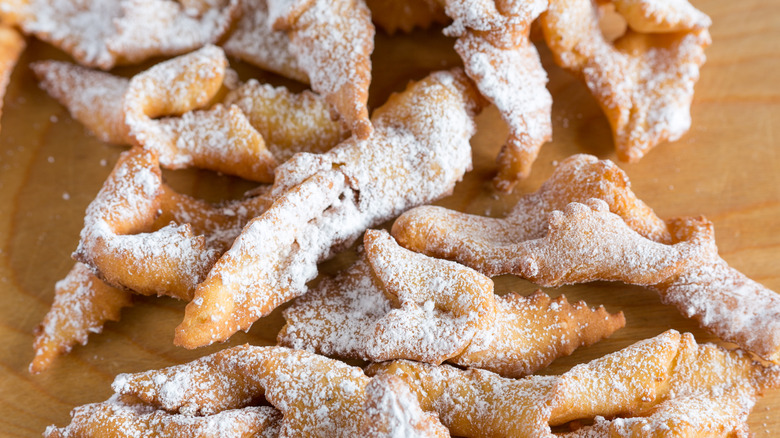15 Norwegian Desserts That You Need To Know About
We may receive a commission on purchases made from links.
If you ever have the pleasure of visiting Norway, you'll find yourself frequently tempted by the country's many unique desserts whose scents perpetually waft out of home kitchens and bakeries. Some of these desserts seemingly have no match in other cuisines — like kransekake, which is made to hide a bottle of champagne. Some desserts are more familiar, though, such as rullekake, otherwise known as the Swiss roll.
To discover more about Norwegian desserts and learn a few tricks of the trade, we chatted with Nevada Berg, author of the blog North Wild Kitchen and the cookbook "Norwegian Baking through the Seasons." Berg believes that if you're willing to don an apron, you can easily recreate many Norwegian desserts at home. She tells us that, "The wonderful thing about Norwegian desserts is how approachable they are. Some have more steps than others, such as Kvæfjordkake and Daimiskake, but they are quite forgiving and good confidence builders once you've made them."
Some of the ingredients you'll want to have on hand for baking Norwegian desserts are eggs, whipping cream, sugar, vanilla, freshly ground cardamom, butter, almonds, and flour. You'll also want to have access to an oven, baking tray, and electric mixer. Many recipes require you to prepare whipped cream, meringue, and custard from scratch, but don't be intimidated; these preparations usually involve only a few simple steps. Ready to have your mouth water? Read on to learn about some of the most popular Norwegian desserts.
Sjokoladeboller
If you're new to baking, Nevada Berg recommends starting off by making a simple boller recipe. She says, "These sweet cardamom buns are a staple across Norway, and the same dough can be used as a base for all other boller variations, such as skoleboller and sjokoladeboller." Once you're ready to try your hand at sjokoladeboller, the steps are quite straightforward: You'll need to prepare a basic dough and knead chocolate chips (or chunks) into it before dividing the mixture into individual buns, glazing them with egg wash, and baking them in the oven. Sjokoladeboller are ubiquitous in Norwegian bakeries, and you shouldn't hesitate to eat these buns when they're fresh and warm, before they lose their signature pillowy softness after being stored for a few days.
For top-notch sjokoladeboller, use freshly ground cardamom and your favorite chocolate. Considering that cardamom pairs excellently with white chocolate, you might want to stray from tradition and experiment with white chocolate chips instead. Sjokoladeboller are flavorful enough to be eaten on their own, but of course, they also go well with a hot cup of tea, coffee, or karsk coffee, an intense Norwegian version of Irish coffee.
Fastelavnsboller
Fastelavn, Norway's version of a Mardi Fras carnival, usually falls in February but sometimes in March. It's a time for letting loose, having fun, and perhaps eating a little more than one strictly needs, especially for those planning to observe the following 40 days of Lent. By far, the most popular Fastelavn food in Norway is fastelavnsboller. In fact, the treat has become so synonymous with the holiday that Fastelavn is sometimes called "Bun Sunday."
Fastelavnsboller are yeast buns, often spiced with cardamom and usually stuffed with whipped cream. These buns can be messy to eat, especially since the whipped cream is often joined by jam, powdered sugar, marzipan, or almond paste. If you only have a bit of a sweet tooth, though, you can omit the whipped cream. You should eat these buns within a day or so, lest they lose their softness.
Nevada Berg tells us that, with any type of bun, you should also "be sure to use a good recipe that provides a soft and pliable dough without the use of too much flour." She adds, "I also bake mine at a slightly higher temperature (200 degrees Celsius or 400 degrees Fahrenheit) for 10 to 12 minutes to ensure they're soft and cooked through with a golden-brown hue."
Riskrem
Rice porridge has variants all over the world, including Japanese o-kayu and Chinese congee. In Norway, it's called risengrynsgrøt, and it's traditionally eaten on Christmas Eve. When combined with whipped cream, though, the dish becomes riskrem. This basic, cold, and sweet dish is among the easiest Norwegian desserts to prepare; all you need is leftover rice porridge, whipping cream or heavy cream, sugar, and vanilla extract. Alternatively, you can combine the sugar and vanilla into one by using vanilla sugar, a common ingredient in Europe. Dr. Oetker's vanilla sugar is a popular choice.
Accompaniments are likewise simple: You can garnish it with sliced almonds, red berry compote, a sauce made from red fruit juice, and/or a handful of berries. If opting for the compote, you may wish to make it well in advance to allow it time to cool. For a smoother sauce, Nevada Berg suggests straining the compote through a sieve. To make the dessert even more interesting, blanch and peel one almond and hide it in the pudding — reward whoever finds it with a treat like a Nidar marzipan Christmas pig; or, make it a guessing game about who has squirreled away the nut in their mouth.
Daimiskake
American ice cream cakes are put to shame when compared to the Norwegian Daimiskake. This cake features a nutty macaron base that first requires eggs and sugar to be beaten into a meringue. Nuts (like almonds or hazelnuts) are added to this batter before it's baked. This lays the foundation for a thick layer of ice cream that may offer tasting notes of vanilla, coffee, or even an alcoholic beverage like whiskey or cognac.
This second layer could be compared to Heath ice cream, made with Daim crunchy caramel bars (hence the dessert's name). An ice cream machine is not required to make this layer; just an electric mixer, freezer-safe bowl, and, of course, a freezer. Instead of icing, Daim makes a reappearance on top of the cake, as well, possibly in addition to caramel sauce. If you love the taste of vanilla, try using fresh vanilla bean to bring the flavor of Daimiskake to a whole new level. Nevada Berg says this dessert that can be made well in advance of serving; in fact, she recommends letting the cake set in the freezer for at least four hours.
Eplekake
Move over, apple pie. Once you try eplekake, or Norwegian apple cake, you won't want any other apple-themed dessert baking in your oven. This treat is particularly common in Norway from August until December — during apple harvest season — but is enjoyed year-round. Eplekake is a sponge cake topped with thinly sliced apples, cinnamon, sugar, and sometimes nuts (like slivered almonds) and butter. Like apple pie, eplekake goes well with a dollop of ice cream or whipped cream, but to make things more interesting, Nevada Berg suggests serving eplekake with brunost, a brown cheese caramel sauce (she recommends Ski Queen gjetost).
When it comes to the best apple variety, Berg tells us, "I like tart apples for eplekake — in Norway, we have a lot of Discovery and Red Aroma apples." Because these varieties are not commonly available in the U.S., cookbook author Florence Fabricant has suggested using another tart apple like Granny Smith. Because of eplekake's popularity, you may be able to find it in the U.S.; for instance, at Disney World's Kringla Bakeri Og Kafe in Epcot.
Sandnøtter
In Norway, Nevada Berg says, "The term syv slag småkaker (seven types of cookies) refers to an old tradition of having seven different kinds of cookies in the tin, as the number seven was thought to bring luck and is an important religious number." Sandnøtter are extremely easy to make, only requiring you to mix a handful of ingredients together before letting the dough rest, fashioning it into balls, then popping those balls into the oven. The simplicity and utter deliciousness of these shortbread cookies are part of the reason why sandnøtter are so often included among the traditional seven cookies baked during Christmastime.
Light and buttery, sandnøtter will flood your tastebuds with the sweetness of sugar and notes of vanilla. In fact, it's their distinct texture that gives sandnøtter their name; the word literally translates to "sand nuts." These cookies are an excellent introduction to baking with potato starch. Berg explains to us, "Potato starch absorbs moisture better than flour, providing a lighter and airier texture. It also helps to keep the shape. With sandnøtter, the potato starch gives it this porous texture that melts in the mouth."
Sirupsnipper
Many Norwegians agree that sirupsnipper are one of the seven cookies traditionally baked during the Christmas holidays. They are similar to gingerbread cookies in texture and flavor — crisp, crunchy, and with the same satisfying snap when you break them in half. They also call for ginger powder and are the same shade of brown.
One of the main differences, however, is their shape. Sirupsnipper are sliced into rhombuses with a fluted blade. An Ateco pastry wheel will help you to achieve this distinctive edge pattern. Additionally, each cookie is topped with one sliced, blanched, and peeled almond. Another difference lies in the type of syrup used; while gingerbread recipes call for molasses, sirupsnipper recipes traditionally call for the less intense flavor of Norwegian syrup (light molasses or golden syrup can work as substitutes for this). Like gingerbread cookies, Nevada Berg notes sirupsnipper tend to keep well in an airtight tin for about two weeks.
Rullekake
If the only Swiss rolls you've had in your life have been Little Debbie's, then you need to try the made-from-scratch dessert fresh from the oven. Rullekake, as the cake is known in Norway, is not strictly a Norwegian dessert, nor is it necessarily Swiss. It's probably from somewhere in Central Europe, such as Austria, but it's so beloved in Norway that it's considered to be a quintessential part of the country's cuisine.
Norwegian rullekake is a sponge cake, typically with a filling of sweet jam and a cooling layer of whipped cream, all rolled into a neat log. The jam can be of any flavor, such as strawberry or raspberry. Nevada Berg recommends preparing a homemade lingonberry compote, if possible. Unfortunately, lingonberries aren't always easy to find in the U.S., so she tells us that, "One can always substitute lingonberries with cranberries or other fruits in season in the local area." If you're ready to try your hand at baking rullekake, make sure to check out our guide to the most affordable jelly roll pans for your price range.
Sitronfromasj
Sitronfromasj is a simple and rewarding lemon mousse that Norwegians have been making for generations. Nevada Berg tells us that you can use any commonly available variety of lemon. Incorporating a variety like Meyer lemons will yield a sweeter mousse, though some people like their desserts more tart. Besides lemons, other common ingredients in sitronfromasj include eggs, sugar, heavy cream, and gelatin. The hardest part about this recipe is waiting a few hours for it to set in the refrigerator.
As is the case with many puddings and mousses, you can also find instant sitronfromasj packets available for sale in Norway. Light and delicate, this would be a great dessert to serve after a spring or summer meal, perhaps in Mason jars for an extra special touch. A dollop of whipped cream on top is optional, but Berg likes to keep it simple with a dusting of lemon zest.
Lussekatter
Lussekatter, though Swedish in origin, are a staple dessert across Scandinavia. Otherwise known as Swedish saffron buns or St. Lucia buns, and a St. Lucia Day treat enjoyed by celebrity chef Marcus Samuelsson, this fragrant dessert consists of swirled dough with a beautiful golden hue from saffron. In a humorous reference to the buns' unique shape, lussekatter translates to "Lucia's cats," and there's no denying the resemblance of these S-shaped buns to a cat's curled tail. Best eaten on the day they're baked, you can nevertheless freeze leftover lussekatter for future delight. Nevada Berg also suggests transforming leftover buns into bread pudding.
To give your buns an extra glow, "bloom" the saffron by steeping it in milk or simple syrup ahead of time. While you're at it, soak a few raisins as well to ensure they don't dry out while baking. It's worth noting that although saffron is a key component of these buns, it can be prohibitively expensive, so turmeric can be substituted for a similar yellow tint. Finally, while lussekatter are typically unfilled, it's not unheard of to stuff the buns with a sweet, buttery filling.
Kvæfjordkake
Otherwise known as verdens beste, or "the world's best cake," Kvæfjordkake is indisputably one of Norway's most popular cakes. It's primarily served on special occasions, such as weddings, birthdays, baptisms, and Norway's National Day. Like so many other Norwegian cakes, Kvæfjordkake builds upon a foundational recipe of sponge cake. However, the actual structure of this cake is fascinating: An almond-studded, airy layer of meringue sits on the bottom, followed by a layer of sponge cake, then a rich custard cream, then another layer of sponge cake, and, to top it all off, a pretty top layer of meringue. Recipes typically forgo a baking pan, rendering Kvæfjordkake a free-form cake and giving it a distinctly homemade aesthetic.
Nevada Berg suggests enhancing Kvæfjordkake's flavors of vanilla and rum by making the cake a day before you plan to serve it, or, at the very least, allowing it to cool in the refrigerator before serving. If desired, you can also garnish the cake with a handful of berries. With a multitude of flavors and textures, we guarantee that Kvæfjordkake will keep your attention from the first to last bite.
Smultringer
If the thought of freshly fried dough from Krispy Kreme or Dunkin' makes your mouth water, just wait till you try smultringer. These Norwegian donuts combine elements of American donuts and an older Norwegian dessert called hjortetakk. Though you may not think of smultringer as cookies, in many households, they actually belong to the traditional seven cookies baked for Christmas.
Unlike American donuts, which lean heavily into sugar and are usually either glazed, frosted, and/or blanketed in sprinkles, traditional smultringer are unglazed and considered tasty enough to enjoy on their own. Still, Nevada Berg recommends repurposing leftover dough into donut holes and serving them with an apple glaze. Smultringer also require a different set of ingredients than American donuts, including spices like cardamom and cinnamon and, in some recipes, horn salt. Also known as baking ammonia or ammonium bicarbonate, horn salt is an ingredient commonly used in Norway to leaven thinner pastries and desserts. Finally, smultringer are traditionally fried in lard rather than vegetable oil, though bakers may use either today.
Suksessterte
Suksessterte translates to "success tart," and is baked whenever there is good fortune to celebrate. Thanks to the cake's signature yellow hue, it's also enjoyed at Easter. Suksessterte has a nutty macaron base, baked then frosted with a sweet, buttery, vanilla-infused egg custard. Almonds and hazelnuts are commonly used for the base, though this is not set in stone, and chocolate is sometimes, but certainly not always, drizzled over the top. When made during Easter, suksessterte may be decorated with chocolate eggs and other springtime motifs.
The good news, if you're a home baker, is that this cake is very easy to master, giving you all the more reason to celebrate your success by slicing another piece. Just make sure to properly whip your eggs into peaks for the base and not let the eggs curdle when making the custard. For a perfectly thick custard, Nevada Berg recommends allowing the egg mixture to simmer on the stovetop for a short while, making sure not to stop stirring.
Skoleboller
Skoleboller, as the buns are commonly known in western Norway, or skolebrød, as they are often known in the east, start with a soft, sweet, cardamom-scented yeast dough, with vanilla custard, glaze, and dried coconut flakes. If you're baking them yourself, be sure to make the center indentations deep enough for the custard, keeping in mind that the dough will rise while baking. Nevada Berg suggests using a pestle for a perfectly round indentation. If you're not fond of coconut, it's an optional ingredient, and the buns are just as good without it if you're baking at home.
Skoleboller translates to "school buns," which makes sense considering that in the mid-20th century, children started to enjoy these sweet treats during their afternoon meals. If you'd like to pack a bun for lunch yourself, keep it fresh and safe during transport by giving it a separate airtight container, unless you want shredded coconut all over your turkey sandwich. Otherwise, you can enjoy skoleboller any time and on any occasion; they will last about two days in the refrigerator.
Fattigmann cookies
Fattigmann may translate to "poor man," but don't be fooled by the name of these cookies; they are rich in taste and enjoyed by people of all classes in Norway. These classic Christmas treats consist of an alcohol-infused dough that's given fluted edges and twisted into knots before being deep fried. Once cooked, they're occasionally sprinkled with powdered sugar and cinnamon. They require a bit of forward thinking, as the dough typically must rest in the refrigerator overnight, but it'll be worth the effort when you take the first sweet, crispy bite.
Whether you use cognac, brandy, or whiskey is up to you, but including some kind of alcohol can stop the cookies from soaking up too much oil during cooking. You can be traditional and fry them in lard or use vegetable oil. Nevada Berg emphasizes that one should not be intimidated by the shape of fattigmann, as homemade cookies will likely take on a lovely, rustic appearance. Fattigmann are some of the better cookies to make in advance, as they can keep well for up to a week.
